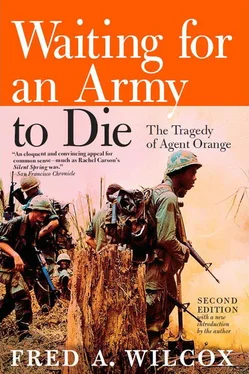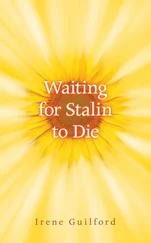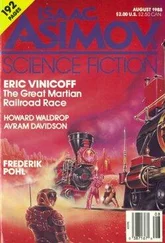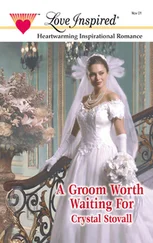3. Ton That Tung, MD, Ton Duc Lang, MD, and Do Duc Van, MD (Viet Duc Hospital, Hanoi, Vietnam), “The Problem of Mutagenic Effects on the First Generation after Exposure to Defoliants”; Ton That Tung, Ton Duc Lang, and Do Duc Van, “The Mutagenacity of Dioxin and Its Effects on Reproduction among Exposed War Veterans,” unpublished papers.
4. Ibid.
5. Arthur W. Galston, “Herbicides in Vietnam,” New Republic , November 25, 1967.
6. Martin Woollacott, “Agent Orange Still Takes Toll,” The Guardian , reprinted in US and World Section of the Boston Globe , June 4, 1980.
7. Testimony of Maureen Ryan before the Committee on Veterans’ Affairs, US Senate, February 21, 1980.
8. Thomas Whiteside, The Withering Rain: America’s Herbicidal Folly (New York: Dutton, 1971), p. 46.
9. “Vets Told Agent Orange Decision Is Years Away” (AP), Ithaca Journal , September I, 1982.
1. Graham Bell, “Agent Orange: ‘It Won’t Even Hurt Dumb Animals,’” Grifitti , student newspaper of Griffith University (Australia).
2. John Dux and P. J. Young, Agent Orange: The Bitter Harvest (Sydney: Hodder and Stoughton, 1980), p. 67.
3. Ibid., p. 63.
4. Ibid., p. 131.
1. Statement of the National Veterans Law Center before the Subcommittee on Medical Facilities and Benefits of the Committee on Veterans’ Affairs, US House of Representatives, July 22, 1980.
2. Ibid., p. 6.
3. Ibid.
4. Report by the comptroller general of the United States, “Health Effects of Exposure to Herbicide Orange in South Vietnam Should Be Resolved,” April 6, 1979, p. 12.
5. Ibid., p. 6.
6. Statement of the National Veterans Law Center, p. 14.
7. Ibid., p. 16.
8. Ibid., p. 16–18.
9. Testimony of Philip Handler, president, National Academy of Sciences National Research Council, Washington, D.C., before the Subcommittee on Medical Facilities and Benefits of the Committee on Veterans’ Affairs, US House of Representatives, September 16, 1980.
10. Ibid.
11. Seymour M. Hersh,
Chemical and Biological Warfare: America’s Hidden Arsenal
(Indianapolis: Bobbs-Merrill, 1968), pp. 153–54.
12. Statement of William J. Jacoby Jr., MD, deputy chief medical director, Department of Medicine and Surgery, Veterans Administration, before the Subcommittee on Oversight and Investigations, Committee on Veterans’ Affairs, US House of Representatives, May 6, 1981, pp. A-3-A-4.
13. Public Hearings, New York State Temporary Commission on Dioxin Exposure, Farmingdale, New York, June 20, 1981.
14. Ibid.
15. Ibid.
16. Statement of Max Cleland, administrator of veterans’ affairs, before the Committee on Veterans’ Affairs, US Senate, February 21, 1980.
17. Statement of the National Veterans Law Center, p, 22.
18. Ibid., p. 24.
19. New York Times , August 18, 1981.
20. The American Legion , January 1982, p. 7.
21. Ibid.
22. Washington Post , November 19, 1981.
23. “Vets Told Agent Orange Decision Is Years Away,” Ithaca Journal , September 1, 1982.
24. Ibid.
25. “VA Turns over Agent Orange Study to HHS Unit,” Washington Post , October 15, 1982.
7 - WHEN YOU CAN’T SUE THE GOVERNMENT THAT KILLS YOU
1. Karen J. Payne, “Beyond Vietnam, Beyond Politics, Beyond Causes…,” Barrister , Spring 1979.
2. Victor J. Yannacone, W. Keith Kavenagh, and Margie T. Searcy, “Agent Orange Litigation: Cooperation for Victory,” Trial , February 1982.
3. Ibid.
4. Victor J. Yannacone, W. Keith Kavenagh, and Margie T. Searcy, “Dioxin, Molecule of Death,” Trial , December 1981.
5. Victor J. Yannacone et al., “Agent Orange Litigation: Cooperation for Victory,” Trial , February 1982.
6. Ibid.
7. Ibid.
1. Direct testimony of Dr. Michael L. Gross before the administrator, United States Environmental Protection Agency.
2. Ibid.
9 - HUMANS, RATS, AND LESSER BEINGS
1. Matthew Meselson, interview with filmmaker Daniel Keller, February 26, 1981.
2. Federal Register, “Emergency Suspension Order for 2,4,5-T and Silvex” 15874–15920, March 15, 1979.
3. Drs. Ton That Tung, Ton Duc Lang, and Do Duc Van (Viet Duc Hospital, Hanoi, Vietnam), “The Mutagenacity of Dioxin and Its Effects on Reproduction among Exposed War Veterans,” unpublished paper.
4. David Kriebel, “The Dioxins’ Genetic Risks,” Center for the Biology of Natural Systems, Washington University, St. Louis, Missouri, August 1979.
5. Statement of Dr. Steven D. Stellman, assistant vice president for epidemiology, American Cancer Society, before the Subcommittee on Veteran’s Affairs, US House of Representatives, July 22, 1980.
6. Testimony of Dr. Samuel S. Epstein, School of Public Health, University of Illinois Medical Center, before the Subcommittee on Medical Facilities and Benefits of the Committee on Veterans’ Affairs, US House of Representatives, July 22, 1980.
7. L. Hardell and A. Sandstrom, British Journal of Cancer , Vol. 39 (1971), p. 711.
8. O. Axelson et al., Läkartidningen , Vol. 76 (1979), p. 3505.
9. M. Eriksson et al., Läkartidningen , Vol. 76 (1979), p. 3872.
10. A. M. Thiess and Frentzel-Beyme, “Mortality of Persons Exposed to Dioxin after an Accident Which Occurred in the BASF on the 13th of November, 1953,” Medichemen Congress, University of San Francisco, September 5–9, 1977.
11. M. Eriksson et al., “Soft Tissue Sarcomas and Exposure to Chemical Substances: A Case-Referent Study,” British Journal of Industrial Medicine, Vol . 38 (1981), pp. 27–33.
12. Thomas Whiteside, The Pendulum and the Toxic Cloud: The Course of Dioxin Contamination (New Haven and London: Yale University Press), 1979, pp. 38–39.
13. Ibid., pp. 116–17.
14. Ibid., p. 120.
15. Ibid., pp. 120–21.
16. Ibid., p. 124.
17. Ibid., pp. 74–75.
18. Statement of Robert O. Muller, executive director, Vietnam Veterans of America, before the Subcommittee on Medical Facilities and Benefits of the Committee on Veterans’ Affairs, US House of Representatives, July 22, 1980.
19. Sierra Club presentation, WIXT, June 27, 1980.
20. Statement of Dr. Jeanne M. Stellman, associate professor of public health, Division of Environmental Sciences, Columbia University, before the Subcommittee on Medical Facilities and Benefits of the Committee on Veterans’ Affairs, US House of Representatives, July 22, 1980.
10 - THE VIETNAMIZATION OF AMERICA
1. “The Globe Incident: 1969–81,” New Times , June 3–9, 1981.
2. “Herbicide Concerns: A Basic Introduction,” Northwest Coalition for Alternatives to Pesticides (NCAP), P.O. Box 375, Eugene, Oregon 97440.
3. Jack Anderson, Washington Post , April 24, 1978.
4. Phil Keisling, “The Praying of Oregon,” Willamette Week , December 31, 1979.
5. NCAP Staff, “The Saga of 2,4,5-T,” NCAP News , Fall-Winter 1981–82.
6. Philadelphia Inquirer , October 31, 1982.
7. “Herbicide Information Packet,” Northwest Coalition for Alternatives to Pesticides (NCAP), p. 65.
8. Ibid., pp. 66–67.
9. Ibid., pp. 67–68.
10. Paul Merrell, “IBT Officials Indicted for Fraud,” NCAP News , Spring–Summer 1981.
11. Ibid.
12. Ibid.
FRED A. WILCOX has been a scholar on the Vietnam War for the past thirty years. He has published numerous articles and made several media appearances as a trusted authority on the war and its aftereffects. He teaches at Ithaca College.
Читать дальше











